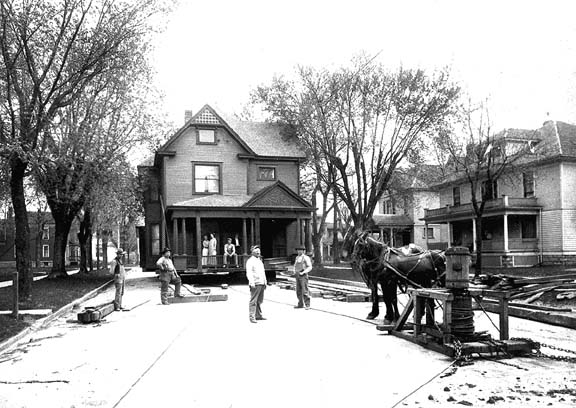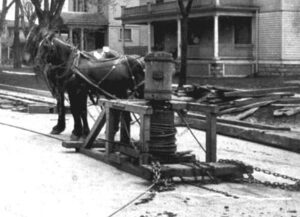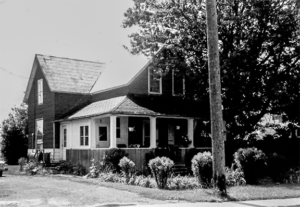The Presence of the Past in Rideau Township: When “Moving House” was a Literal Term

In the early days the term "moving house” once had a more literal meaning than it usually does today. Probably for economic reasons, many village homeowners who decided to move to a new location within the area brought their houses with them. The process involved usually lasted a few weeks and entailed a certain degree of inconvenience, but was evidently worthwhile.
That it was possible to move so many buildings was due in part to their sturdy construction, but more particularly to the skill and ingenuity of the movers – men such as Jack Baldry (1879-1966) who moved several buildings in North Gower. Baldry, who also framed many barns and houses in the area, lived in a house on the site of the current library. He is well-remembered for his colourful language, and also a reputation as a demanding employer who was known-to hire and fire a man on the same day. This was understandable though: given the nature of the work, a careless employee could easily topple a house on to its side with disastrous consequences!
The work appears to have been painstaking and slow. The first step was to slowly raise the house with jack screws. These came in different sizes and heights and could lift from 5 to 25 tons. Then long, squared timbers (usually two) would be slipped underneath the house. At the same time, one-wheeled dollies were placed under each timer. A minimum of three dollies would be used for each timber, and perhaps more depending on the size of the building. As the house moved, the end dolly would be brought to the front of the house and slipped under the timber again. After these preparations the house could be moved, but a source of power was still needed.
Jack Baldry seems to have done most of his moving in the 1920's and 1930's, but the pactice of house moving is considerably older. In 1826 John Thomson had his log house moved about one kilometer to where it stands today. How he did it is not known, but he probably used some kind of timber sled pulled by horses.
As mentioned, the average in-town house move lasted about two weeks, but sometimes unexpected snags could arise. In 1933 the Marlborough Township Hall was moved from its original site (Lot 9, Concession 3) but became bogged down in snow before it could reach its new home in Pierce's Corners. The move had to be completed in 1934.
Today it seems that far fewer homes are moved, and those that are are usually long and narrow buildings designed to be portable. Perhaps people today are less attached to their homes, or perhaps it simply makes more financial sense to sell the home. In any event, it appears that the skills and relatively simple technologies employed by a man like Jack Baldry are no longer needed. The ability to move entire houses with pieces of wood and horses strikes one as a fascinating talent. However, today it sounds like an art whose time has passed.

Horses with Capstan (location/date unknown)
This was usually provided by horses, either singly or in pairs. A wooden capstan would be anchored to the ground some distance from the house and a rope, length of cable or chain of linked steel rods would be attached to the capstan from the house. A capstan's installation was referred to as "burying a deadman" and it was held in place with iron pins. The horse, or pair of horses, would be harnessed to the capstan's arm or "sweep" and as they walked around the capstan they would step over the wire and winch the house forward. Jack Baldry and his crew would keep busy laying a level track of planks and timbers for the dollies to travel over. Often, the houses were moved across fields or in ditches if they had to be moved along a road. If the house was small enough, then the capstan method might be abandoned in favour of a straight ahead pull from the horses. The Parks house was moved in this fashion while the house immediately north of the Bank was moved with a capstan. Another North Gower building that is known to have been moved is the white frame house that was, until recently, The Craig farm machinery store. This building, once the house of the tinsmith, J. Wesley Matthews, was located, until 1940, back from the street on the bank of Steven's Creek.

Now located north of the Bank on the west side of Main Street in North Gower, this house was originally on the cast side of Main Street, south of Roger Stevens Drive.
Jack Baldry seems to have done most of his moving in the 1920's and 1930's, but the pactice of house moving is considerably older. In 1826 John Thomson had his log house moved about one kilometer to where it stands today. How he did it is not known, but he probably used some kind of timber sled pulled by horses.
As mentioned, the average in-town house move lasted about two weeks, but sometimes unexpected snags could arise. In 1933 the Marlborough Township Hall was moved from its original site (Lot 9, Concession 3) but became bogged down in snow before it could reach its new home in Pierce's Corners. The move had to be completed in 1934.
Today it seems that far fewer homes are moved, and those that are are usually long and narrow buildings designed to be portable. Perhaps people today are less attached to their homes, or perhaps it simply makes more financial sense to sell the home. In any event, it appears that the skills and relatively simple technologies employed by a man like Jack Baldry are no longer needed. The ability to move entire houses with pieces of wood and horses strikes one as a fascinating talent. However, today it sounds like an art whose time has passed.
